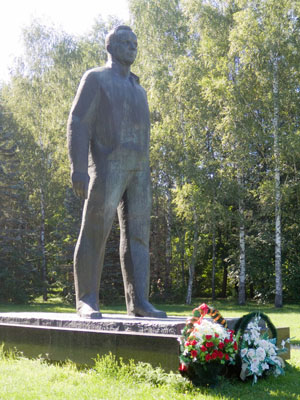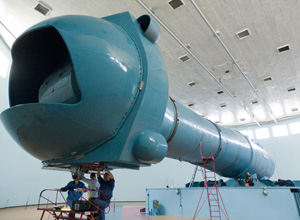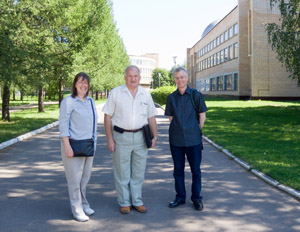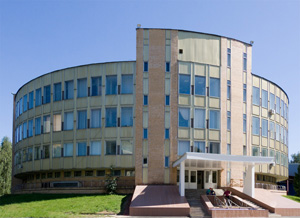| It is sunny and hot in Moscow. The road
out of the city to the north-east, past apartment blocks
and factories, is jammed with traffic and there is a
queue onto the Moscow Circle Automobile Road; the A103 is
no better. The apartments give way to country houses with
elaborate wooden facades, but the passing traffic
generates fumes that choke the air. Modern European Audis
and VWs, and Japanese Hondas might generate little
pollution, but ageing Ladas and lumbering trucks make up
for them. Twenty-five kilometres out from Moscow, there
are fields and scattered 'dachas', and then the big radio
dish at Shchyolkovo appears across the treetops. Just by
the Chkalovskiy air base a smaller road runs away to the
south-east, bordered on one side by trees and a wall, the
other by the railway line running to Monino. Another
three kilometres and there is a building with the words Yuri A. Gagarin
Centre for Cosmonaut Training. To the left is a gate
in the wall guarded by military personnel. For those
without the right papers, there is no entry. Once through
the gate it is a different world: quiet and peaceful, the
air is clean, and the road passes between trees. After a
few hundred metres there is a parking area. On the left a
larger-than-life statue of Yuri A. Gagarin keeps watch.
To his left a long, wide area of mown grass and
flowerbeds runs for several hundred metres up to the
House of Cosmonauts. Either side are apartments where
cosmonauts live, a few shops, and a post office. To the
right of the car park, and towards where Gagarin's gaze
is directed, is another fence with a guarded entrance.
There is the training centre where Russian cosmonauts
(and American astronauts and European Spationauts) learn
how to live and work in space.
|
 |
| Through the gate of the training centre
and to the right is a cylindrical building that houses
the largest centrifuge in the world. Known as TsF-18, it
was built in 1980, has a radius of 18 metres and can
subject a person to loads of up to 30g. In the words of
the training centre 'It is used for cosmonaut selection
and training by simulating the bad factors of space
flight.' That is: g-forces, micro-gravity and low
cabin-pressures, temperatures and humidity. If a would-be
cosmonaut cannot survive the centrifuge, he or she will
not be going into space! Complementary tests to simulate
weightlessness are carried out in Ilyushin-76 aircraft
which fly 'parabolic arcs' to give 25 - 30 second periods
of zero-gravity. |
 |
| Just getting out of his car, Hero of the
Soviet Union and Pilot-Cosmonaut of the USSR Viktor
Mikhailovich Afanasyev, veteran of four missions into
space, has time for a photograph and a quick chat.
Afanasyev has accumulated a total of 555 days in space,
most of them in the Mir space station. During seven EVAs
he has notched up 38 hours in open space. Following his
first mission he returned to Earth with British astronaut
Helen Sharman after her week onboard Mir. Afanasyev is
currently the Deputy Head of the cosmonaut corps at the
training centre. |
 |
| At the end of the road that passes the
cosmonauts offices and the planetarium, is another
cylindrical building. This is the hydrolaboratory, also
opened in 1980, basically a huge tank containing 5,000
cubic metres of water. The underwater environment
simulates the weightlessness of space and cosmonauts can
practice working in their spacesuits as if they were
carrying out an EVA in space. Full-size models of
spacecraft can be submerged in the tank to allow
cosmonauts to practice the tasks they will carry out
during a spacewalk. In the past, the tank contained a
mock-up of Mir, now there is Zvezda, the core Russian
module of the ISS, and PIRS, the docking compartment. Heading
back down the road on the right, one first passes the ISS
simulator building, and then the Mir and Soyuz simulator
buildings. The Mir simulator is now a museum piece and
another (smaller) statue of Gagarin welcomes visitors.
The room contains full-size models of the Mir base-block,
Kvant, Kvant-2 and Kristall, used for training during the
1980s and 90s. A cosmonaut dummy called Ivan Ivanovitch
(literally John Johnson) sits in a mock-up of a Soyuz
seat. The joke is that although many nations have sent
someone named 'John' into space, there has never been a
Russian cosmonaut of that name!
|
 |
| Back outside the centre, in front of
Gagarin's statue, Valentina Vladimirovna Tereshkova, the
first woman in space, is being interviewed by a
television crew. A short visit to the shop in the House
of Cosmonauts to buy a souvenir pennant of Star City, and
it is time to leave the tranquillity of the centre and
head back to the hustle and bustle of Moscow. |
 |




